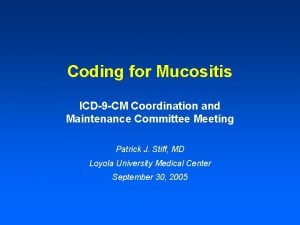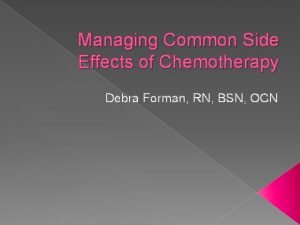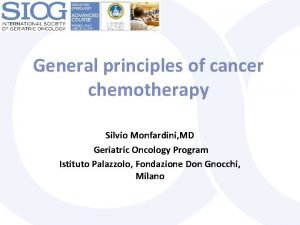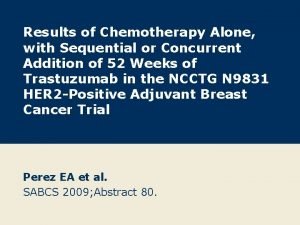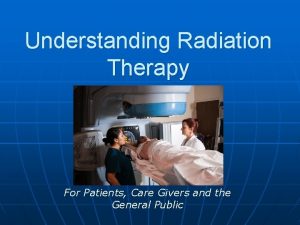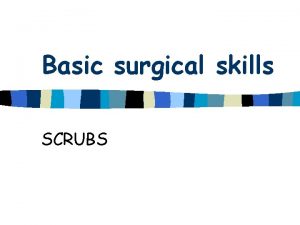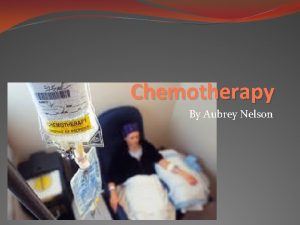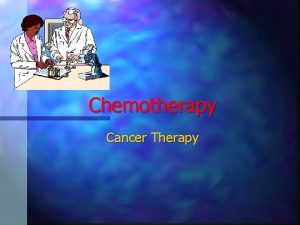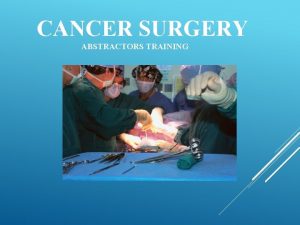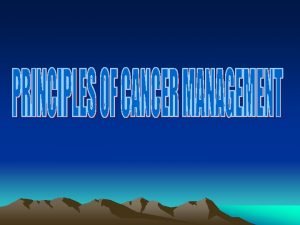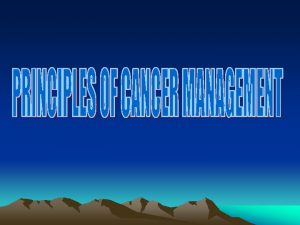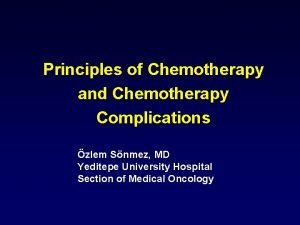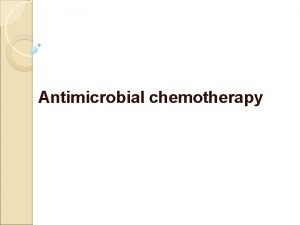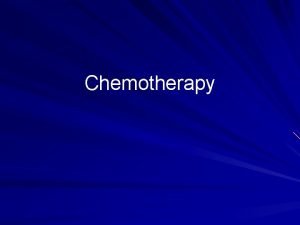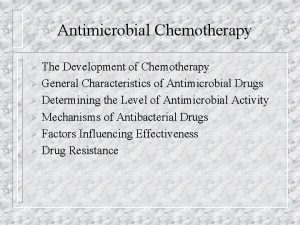CANCER TREATMENT CANCER TREATMENT 1 Surgery 2 Chemotherapy














- Slides: 14

CANCER TREATMENT

CANCER TREATMENT • • 1. Surgery 2. Chemotherapy 3. Radiation 4. Targeted Therapy 5. Immunotherapy 6. Hormone Therapy 7. Stem Cell Therapy 8. Precision Medicine

1. Surgery: remove or destroy tumors • Laser Surgery: precise and can use fiber optics • Cryosurgery: freeze the tumors • Skin cancer removal – jump to 1: 00 • Electrosurgery • Radiofrequency Ablation: using highly focused microwaves to burn out a tumor • Laparoscopic Surgery: Making tiny external incisions and using tiny probes, instruments, and cameras to work inside the body • Laparoscopy Animation • Liver Cancer Laparoscopy • Robotic • Origami • Sutures

• 2. Chemotherapy: - uses toxic compounds to target fast growing cells • - can’t differentiate between cancer and healthy fast growing cells such as hair, skin, blood, and the lining of the digestive system = common side effects of chemo • • • - hair loss - dry itchy skin - digestive issues - pain - lethargy and exhaustion

3. Radiation A. External • Tumor Bombardment • Therapy – jump to 1: 30 • Gamma Knife B. Internal - Brachytherapy • Radioactive materials such as wires or small “Seeds” are implanted in the tumor • Seeds give off localized radiation to destroy the tumor


• 4. Targeted Therapy • Targeting Cancer Metabolism - Cancer Cell Metabolism differs from normal cell metabolism – targeting these differences with specific drugs can interfere with the growth of the cancer and kill it - Targeted therapy treats the patient with specific medicines that “target” a specific molecule within the cancer cell to block the growth, progression, and spread of the cancer

• Targeted Therapy vs. Chemotherapy • Chemo affects all actively growing cells while targeted affects molecules only associated with cancer cells • Chemo is napalm and target therapy is a sniper • Challenges: • - finding the target proteins that differ in cancer cells • Monoclonal Antibody Carriers –

• 5. Immunotherapy • - specific type of targeted therapy using antibodies to bind to the surface of cancer cells so the human immune system can identify and destroy the cells • May involve boosting the production of the immune cells • The identity game

• Types: Monoclonal Antibodies: cancer cell’s identifying proteins are injected into mice so their immune systems will develop antibodies against them • These antibodies are harvested from the mice, and “humanized” to make them more usable by the human body – Making Monoclonal Antibodies • These are mass produced and then injected into the patient • Ted Talk – jump to 6: 00

• Adoptive Cell Transfer: • T-cells are removed from the patient and grown in mass quantities and then injected back into the patient • T-cells are the immune cells that identify and destroy foreign cells Cytokines: = Cell movement – chemicals released by the body to cause immune cells to activate – injected into the patient to rev up the immune cells

• 6. Hormone Therapy: uses hormones to disrupt the signals of cancers that rely on hormones to grow. These therapies either block the production of the hormones that stimulate the cancer or they interfere with how the hormones operate. • Ex. Breast and prostate cancers

• 7. Stem Cell Therapy: • Many cancers such as leukemia or lymphoma require the destruction of the bone marrow. Stem cell therapy restores the stem cells of the bone marrow so the patient can recover.

• 8. Precision Medicine: Specifically tailoring treatments to the specific genetics of the cancer of the patient. The cancer is genetically screened to determine the precise mechanism of growth in order to individualize treatment.
 Icd 9 code for aphthous ulcer
Icd 9 code for aphthous ulcer Debra forman
Debra forman Principles of chemotherapy
Principles of chemotherapy Caf process
Caf process General principles of chemotherapy
General principles of chemotherapy 4ac 4t chemotherapy
4ac 4t chemotherapy Bsa calculation formula for chemotherapy
Bsa calculation formula for chemotherapy Chemotherapy
Chemotherapy Treatment of inflammatory breast cancer
Treatment of inflammatory breast cancer Cancer treatment
Cancer treatment Turbenectomy
Turbenectomy B&l hansatome microkeratome
B&l hansatome microkeratome Wound classification surgery
Wound classification surgery Manor surgery beeston
Manor surgery beeston Queensbridge medical centre
Queensbridge medical centre
